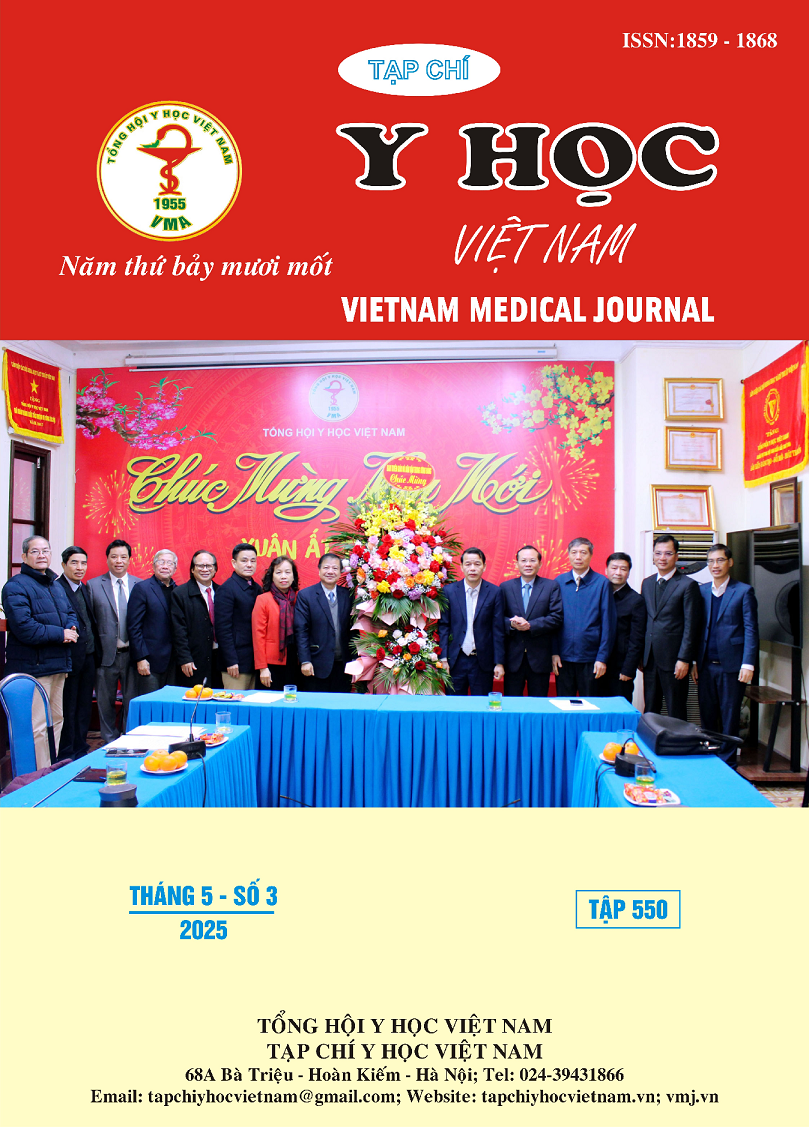ASSOCIATION BETWEEN MODIFIED NUTRIC SCORE (mNUTRIC) AND CLINICAL OUTCOMES IN PATIENTS WITH SEPTIC SHOCK
Main Article Content
Abstract
Introduction: Patients with septic shock face multiple risks, including nutritional challenges. Currently, there is a lack of easily applicable nutritional screening tools in clinical practice for assessing patients with sepsis and septic shock. Objective: To investigate the association between nutritional risk, as assessed by the mNUTRIC score and clinical outcomes in patients with septic shock. Methods and Subjects: A cross-sectional study was conducted on 151 patients with septic shock admitted to the Intensive Care Unit of Hoan My Cuu Long Hospital from January 2023 to December 2024. Results: High nutritional risk was observed in 61.6% of patients. Patients with high nutritional risk had higher rates of neurological dysfunction (76.3%), renal dysfunction (74.2%), thrombocytopenia (49.5%), respiratory failure (90.3%), and refractory shock (39.8%). The 30-day mortality rate was significantly higher in the high-risk group (58.1%) compared to the low-risk group (13.8%), with an adjusted HR=2.56 (95% CI: 1.05–6.25, p=0.039). Additionally, the need for renal replacement therapy, mechanical ventilation, and in-hospital mortality were also higher in patients with mNUTRIC scores ≥5. The mNUTRIC score predicted mortality with AUC=0.74 (95% CI: 0.67–0.82, p<0.001). Conclusion: Patients with high nutritional risk were associated with increased rates of organ dysfunction and higher 30-day mortality. The mNUTRIC score is fairly predictive of 30-day mortality in patients with septic shock.
Article Details
Keywords
mNUTRIC, septic shock, mortality prediction
References
2. Van Wyngene L, Vandewalle J, Libert C. Reprogramming of basic metabolic pathways in microbial sepsis: therapeutic targets at last? EMBO molecular medicine. Aug 2018;10(8). Doi: 10.15252/emmm.201708712.
3. Lew CCH, Yandell R, Fraser RJL, Chua AP, Chong MFF, Miller M. Association Between Malnutrition and Clinical Outcomes in the Intensive Care Unit: A Systematic Review [Formula: see text]. JPEN Journal of parenteral and enteral nutrition. Jul 2017;41(5):744-758. Doi: 10.1177/0148607115625638.
4. Liu J, Zhou G, Wang X, Liu D. Metabolic reprogramming consequences of sepsis: adaptations and contradictions. Cellular and molecular life sciences: CMLS. Jul 29 2022;79(8) :456. Doi: 10.1007/s00018-022-04490-0.
5. Prakash J, Verma S, Shrivastava P, et al. Modified NUTRIC Score as a Predictor of All-cause Mortality in Critically Ill Patients: A Systematic Review and Meta-analysis. Indian journal of critical care medicine: peer-reviewed, official publication of Indian Society of Critical Care Medicine. May 2024;28(5):495-503. Doi: 10.5005/jp-journals-10071-24706.
6. Nandhabalan P, Ioannou N, Meadows C, Wyncoll D. Refractory septic shock: our pragmatic approach. Critical care (London, England). Sep 19 2018;22(1):215. Doi: 10.1186/s13054-018-2144-4.
7. Jeong DH, Hong SB, Lim CM, et al. Comparison of Accuracy of NUTRIC and Modified NUTRIC Scores in Predicting 28-Day Mortality in Patients with Sepsis: A Single Center Retrospective Study. Nutrients. Jul 17 2018;10(7). Doi: 10.3390/nu10070911.
8. Hai PD, Viet Hoa LT. The Prognostic Accuracy Evaluation of mNUTRIC, APACHE II, SOFA, and SAPS 2 Scores for Mortality Prediction in Patients with Sepsis. Critical care research and practice. 2022; 2022: 4666594. Doi: 10.1155/2022/ 4666594.
9. Kim SM, Ryoo SM, Shin TG, et al. Early Mortality Stratification with Serum Albumin and the Sequential Organ Failure Assessment Score at Emergency Department Admission in Septic Shock Patients. Life (Basel, Switzerland). Oct 2 2024;14(10). Doi: 10.3390/life14101257.
10. Zhu Y, Zhang R, Ye X, Liu H, Wei J. SAPS III is superior to SOFA for predicting 28-day mortality in sepsis patients based on Sepsis 3.0 criteria. International journal of infectious diseases: IJID: official publication of the International Society for Infectious Diseases. Jan 2022;114:135-141. Doi: 10.1016/j.ijid.2021.11.015.


